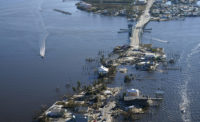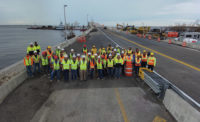In the aftermath of Hurricane Idalia, which made landfall in Florida on Aug. 30 and moved through parts of Georgia, inspections for structural damage to bridges, roadway clean-up and power restoration, continue after flooding. But reports are that the toll of the storm on infrastructure and buildings was relatively insignificant.
After inundating parts of Florida and Georgia, Hurricane Idalia moved through the Carolinas and out into the Atlantic Ocean on Aug. 31. President Joe Biden declared disaster areas in several Florida counties, among them Citrus, Dixie, Hamilton, Lafayette, Levy, Suwannee and Taylor, opening the way for full federal funding for debris removal and emergency protective measures.
The Category 3 storm made landfall near Keaton Beach in Florida’s Big Bend region around 7:45 a.m., Aug. 30, according to the National Oceanic and Atmospheric Administration, bringing winds of up to 125 mph and storm surges of nearly 7 ft.
"As far as the Gulf Coast is concerned, we definitely dodged a bullet with the storm hitting the Big Bend area," says Steve Cona III, president and CEO of Associated Builders and Contractors (ABC) Gulf Coast Chapter.
Based in Tampa, the chapter includes the west coast of Florida, from Gainesville south to Naples. Other than some flooding in the Tampa Bay region, Cona says, there haven't been major impacts.
"There are three tower cranes by my office," he said Aug. 31. "They're all back in business today."
Cona says he also hasn't heard from any members with damaged construction sites. "I think they all did a good job preparing," he says, noting lessons learned from the devastation of Hurricane Ian last year, which washed out bridges and roads, leading to weeks of work to reopen access to some parts of Florida.
"Ian taught us a big lesson last year, so I think more people were way more prepared this time, and we caught a break which was helpful."
Duke Energy: Stronger Grid Means Fewer Impacts
Energy infrastructure recently strengthened with utility pole upgrades and self-healing capabilities stood up well to winds and flooding brought by Idalia, says Audrey Stasko, spokesperson for Duke Energy.
"Most of the damage we saw was due to tree damage that brought down conductors and insulators," she says. "We saw less structures down as compared to Ian."
Stasko credits that to investments the utility has made to strengthen Florida's grid, including ongoing work to install self-healing capabilities for 80% of its customers over the next few years. According to Duke, 60% of its customers in Florida are already served by self-healing capabilities allowing the grid to automatically reroute power to keep electricity flowing.
Larger, stronger utility poles also held up during the storm, she says, and of 16,000 poles Duke reports having replaced in the past two years, Stasko says none of those assessed after Idalia was associated with hardening efforts.
Inspecting Bridges, Clearing Roadways
All bridges in areas affected by the hurricane have been cleared by the Florida Dept. of Transportation (FDOT), according to an update from Gov. Ron DeSantis' office. FDOT has almost 700 personnel dispatched to those areas, including nearly 100 bridge inspectors and 224 cut-and-toss crew members that have cleared more than 6,600 miles of roadway.
FDOT has reopened a majority of state-owned roads and bridges, according to an update Thursday, including hard-hit areas like Interstate-10 in Madison County and the bridge leading to Cedar Key on the west coast which was completely submerged following Idalia's landfall.
"Overall, state-owned infrastructure fared very well during Hurricane Idalia and there are currently minimal road closures around the state," Michael Williams, FDOT deputy communications director, told ENR Sept. 1. "We do not anticipate any major reconstruction projects associated with Hurricane Idalia."
Twenty-seven four-man teams were able to clear a 15-mile stretch of I-10 in Madison County where an estimated 10,000 downed trees of varying sizes blocked the roadway, FDOT says, reopening the road by 7 p.m Wednesday.
"FDOT crews had all hands on deck and were able to reopen I-10 in less than 12 hours from Idalia's landfall," Williams says.
In Georgia, the state Dept. of Transportation reported Thursday that all of its coastal bridges were open after extensive inspections, including the cable-stayed bridge spanning the Brunswick/Turtle River, and the spur cable-stayed bridge spanning the Savannah River in Savannah-Chatham County.
The Florida Dept. of Environmental Protection has issued an emergency order removing barriers for expediting needed repair, replacement and restoration of structures, equipment, surface water management systems and other infrastructure that may have been damaged by the storm.
With nearly 2 million customers throughout Florida, including the area where the storm made landfall, Duke Energy reported Aug. 31 that around 20,000 customers still without power Thursday morning, and around 135,000 had had their power restored.
Florida Power and Light had restored power to more than 190,000 customers by 8 a.m. Thursday, with around 9,000 still waiting to be restored and plans to have power restored to 95% of those in the hardest-hit areas by Friday.
Georgia Power is assessing damage sustained to the southern and southeastern parts of the state from Idalia's winds, heavy rain and fallen trees, with tens of thousands still without power between Valdosta and Savannah.
Editor’s note: The text of article was updated Sept. 1 to reflect new information.





Post a comment to this article
Report Abusive Comment